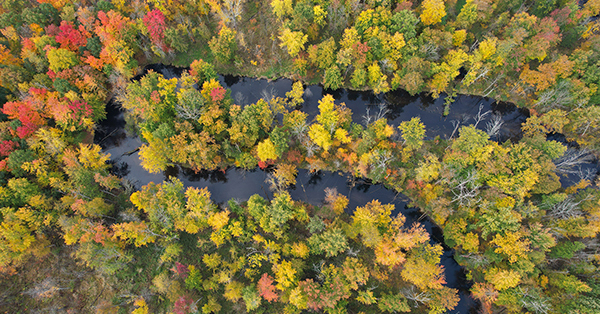DNR Introduces Paw Paw River State Game Area in Van Buren County

The Michigan Department of Natural Resources announces the establishment of the Paw Paw River State Game Area, a new, 350-acre parcel in Van Buren County’s Waverly Township. The DNR will manage this area for wildlife habitat, protecting vulnerable species and enhancing public access to hunting lands and waterways in southwest Michigan.
The new state game area will be an exciting addition to southern Michigan, where most of the state’s residents live but where public hunting lands are limited.
“We are thrilled for this land purchase, as it reinforces our dedication and the dedication of our partners to wildlife conservation and better, broader access to public recreation,” said Mark Mills, southwest regional manager for the DNR Wildlife Division.
Named after its distinguishing geographical feature, the new state game area includes 1.2 miles of frontage on the Paw Paw River. The river stretches 68 miles through southwest Michigan, beginning at village of Paw Paw and eventually joining the St. Joseph River near Benton Harbor.
Increased public access
Located a short distance from the cities of Kalamazoo and Benton Harbor, the state game area will continue to provide opportunities to local hunters and trappers where public access is limited. In Van Buren County, public hunting lands are scarce, with only .02 acres of public hunting land per capita. The property was previously enrolled in the Commercial Forest Program, which allowed public hunting, trapping and fishing. Under DNR ownership, the state game area will continue to accommodate these activities, with improved access and parking.
Anglers and those who enjoy other water-based recreation such as canoeing and kayaking will also benefit from river access and fishing opportunities for resident smallmouth bass, walleye and northern pike, as well as seasonal runs of coho and Chinook salmon and steelhead.
Conservation partnerships
The DNR’s partner in conservation, the Southwest Michigan Land Conservancy, recognized the stretch of land along the Paw Paw River for its current and future importance. The area shares a .5-mile boundary with two conservation easements owned by the conservancy, totaling 398 acres. The conservancy helped facilitate the land acquisition process with the previous landowners, who had expressed desire for the land to remain protected.
Kaleigh Winkler, land protection director for the Southwest Michigan Land Conservancy, said, “The establishment of this new state game area adds to SWMLC’s land protection efforts along this critical riparian corridor identified as a high-priority protection area. Maintaining these floodplain forests protects water quality and all the wildlife that call these important communities home.”
These conservation easements prevent water pollution by protecting critical riparian lands along the banks of these high-quality tributaries and preserving wetland functionality, potential for groundwater recharge (how water from the surface reaches the underground aquifers that store fresh water) and habitat value.
The purchase of this parcel secures the protection of vital habitat in a corridor identified as highly important for climate resiliency and wildlife and plant biodiversity. Together, the properties protect hundreds of acres of contiguous habitat for wildlife and plant species to flourish.
The role of floodplain forests
The land is primarily floodplain forest, a crucial habitat type formed at the meeting point of terrestrial and aquatic ecosystems and a priority habitat in Michigan’s Wildlife Action Plan.
“These places are the foundational building blocks of the food web,” said Kristin Wildman, field operations manager for the DNR Wildlife Division’s southwest region.
The movement of water over floodplain forests creates diverse microhabitats for a variety of wildlife and plant species. During the spring, flooding from the raised river has been shown to thaw soils faster, which allows insects to hatch earlier, creating an available food source for migrating songbirds. The snaking river provides several channel cutoffs and oxbows that create critical pockets of habitat for fish, amphibians, reptiles and waterfowl.
“Floodplain forests create natural corridors for wildlife to travel and plants to spread, which is especially critical in more fragmented landscapes like southern Michigan,” said Don Poppe, DNR wildlife biologist in Van Buren County. Crossing developments such as roads or infrastructure are dangerous and often impossible for slower-moving species such as turtles, snakes or salamanders. “These floodplain and riparian areas continue to be irreplaceable corridors that act to conserve biodiversity by allowing safe passage.”
These forests are uniquely valuable for wildlife habitat, and also for people, as they improve water quality by filtering out water pollutants and sediment, storing access water during flooding events and recharging aquifers with ground water.
For future generations
“The establishment of the Paw Paw River State Game Area provides an immediate benefit to wildlife and ensures stability during an unpredictable future,” Poppe said. “If development occurred on this parcel, we would expect it to impact the river, fish, wildlife, vegetation and the natural aesthetic. With this purchase, we can ensure that current and future generations of humans and wildlife can continue to depend on this area as a natural oasis amid development.”
The property was purchased with a Michigan Natural Resources Trust Fund grant that supports projects providing for natural resource protection and outdoor recreation. The area is open to the public with no time restrictions or entrance fee. The property can be accessed by river or land, with parking available along the roadside of 42nd Avenue. Work is underway to install property boundary signs, and one parking lot will be developed on the western side of the property.
Visitors should take caution that the conditions of the access road are currently variable depending on the weather. Before heading afield, review the land use rules for state-managed land at Michigan.gov/DNRLaws, under the State land use heading.
There are approximately 370,000 acres of state game/wildlife areas in southern Michigan managed by the DNR Wildlife Division. To learn where public lands are, visit Michigan.gov/PublicLands.





